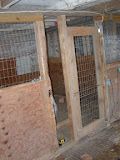Personally I have parts of my property which would be perfectly fine for chicken to create bare earth on because they are not the middle of my lawn and it's mean less yard to mow. They are also areas with great drainage so the chickens won't be standing in mud when it rains. So I'm with you mike001! I don't plan to be raising 100 or 200 chickens any time, ever.
Much depends on your tolerance. Here again, the trap is laid...we are accepting bare and sere earth as part of the experience. It is deemed part and parcel. We have no end of rationale whereby to live with it. In fact, it fascinates me most, that with ten acres at your disposal, you do even seem to welcome it.
What I've come to learn is that, not only do I dislike "cleaning" behind chickens, but I don't have to. There are ways to practically eliminate it, in fact. It can be done in much less space than you think.
Anyway, Ive said my piece. It's in ya'lls hands now. You are on the right track. I have faith in you.


